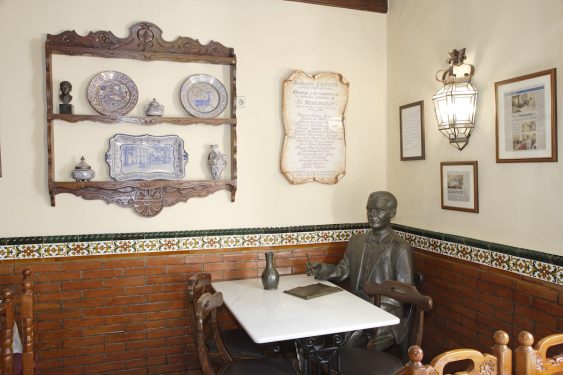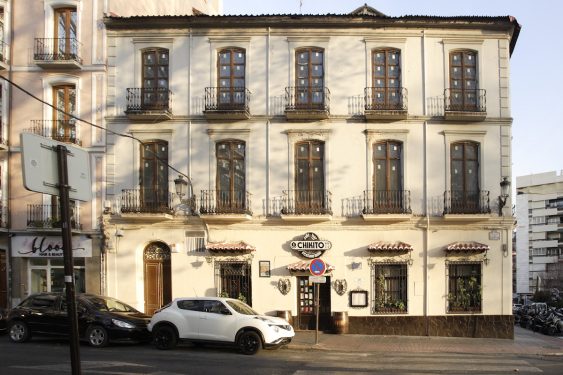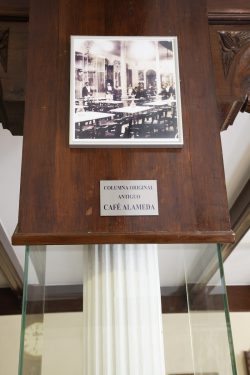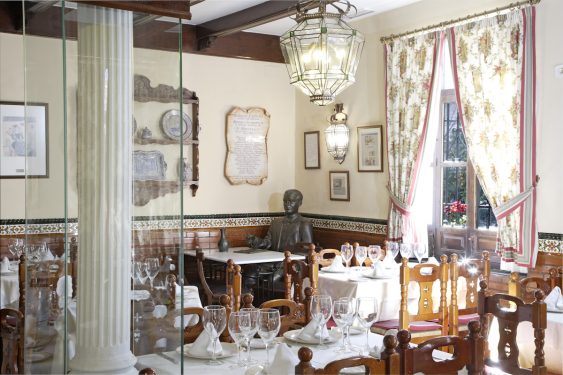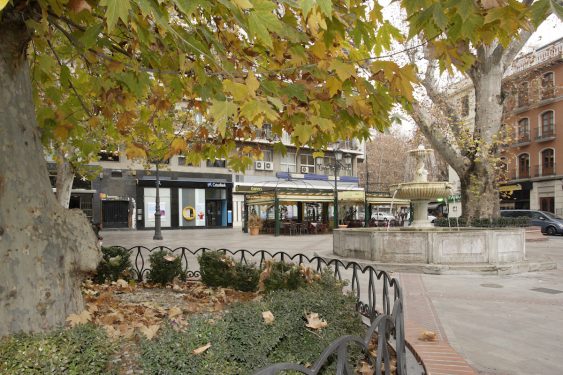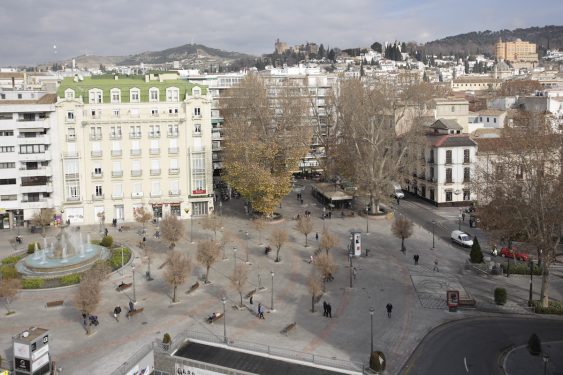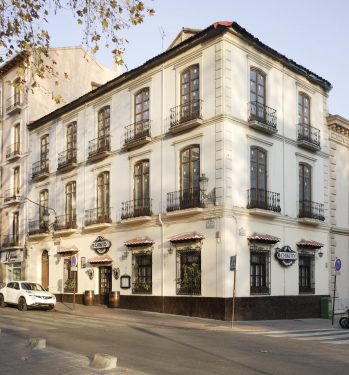Location of the Café Alameda that no longer exists, where El Rinconcillo’s tertulia was located. Today it is part of the Chikito Restaurant.
Rarely has such a small space generated so many groundbreaking ideas or given rise to so much literature and studies as the literary gathering of El Rinconcillo, a few square meters under the staircase leading to the upper floor of the Alameda cafe, an establishment now demolished whose lot is now occupied, just as it was, by the restaurant Chikito. Its founders were the young editors of the magazine Andalucía 1915, an imitation of España 1915, a magazine launched in Madrid to highlight the change of era that took place after the Great War.
The participants in the gathering chose the Café Alameda as the venue, a place frequented by disparate people who varied according to the time of day. At the back of the café, behind the small stage where a string quintet with piano performed, there was “a large corner with two or three tables with comfortable couches against the wall” in which the young frequenters of the café set up their headquarters. After a failed attempt to baptize the nook as La Araña, it finally became what it was, El Rinconcillo.
In the early years, Federico was the only musician in the gathering, until 1918 when he surprised everyone with his first book, ‘Impressions and Landscapes’, whose writing he kept secret.
The current entrance is facing the same direction as the original, and the owners have placed a sculpture of Lorca in the space where the lighthearted members of the tertulia used to sit. In summer, the meeting expanded under the gigantic trees of the Campillo Square that have survived all the urban development.
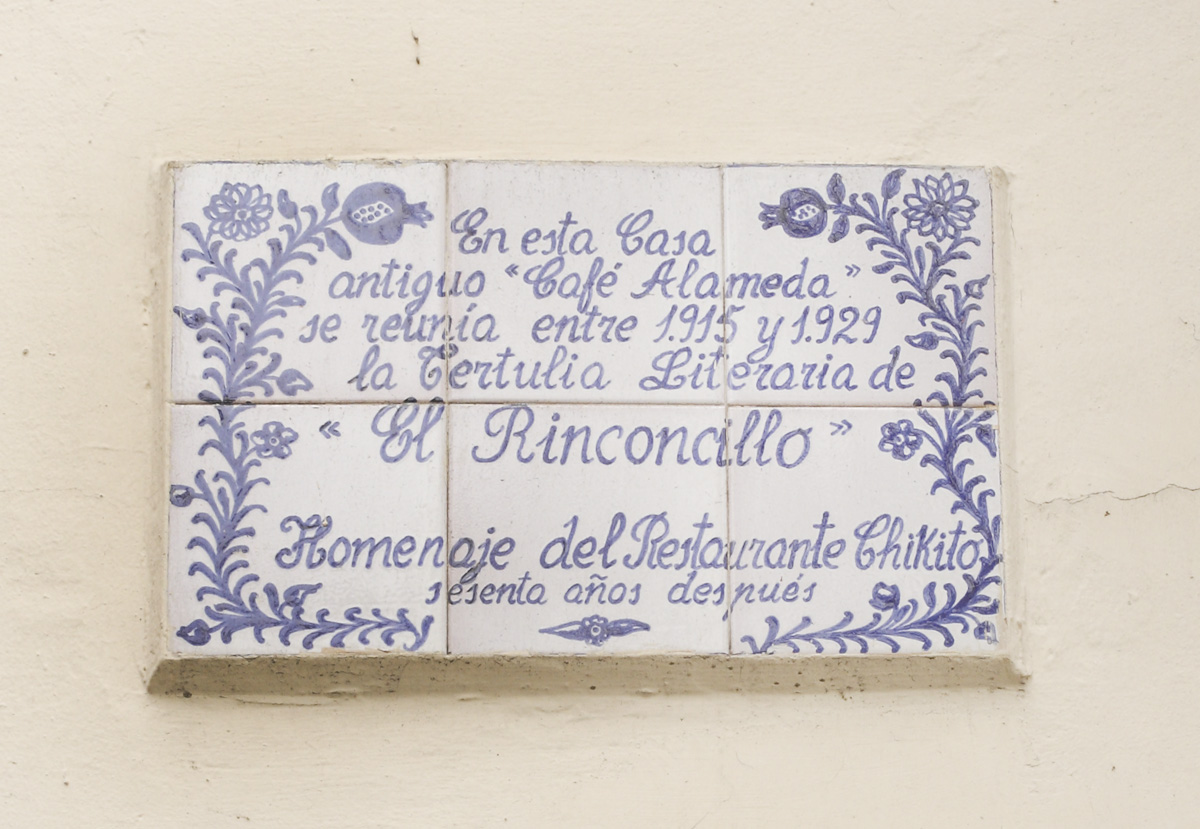
El Rinconcilllo was founded as a consequence of the decline of the Centro Artístico, from which its younger members had separated due to its “provincialism” and its attachment to the more traditionalist plastic arts. Its most glorious period took place between 1915 and 1922; from then on, its commitment declined as many of the attendees left Granada. Some of its last members founded in 1926 the Ateneo de Granada , which followed the path of audacity against the pomp of the Centro Artístico.
Proof of the open and universal spirit of the rinconcillistas is that two of its most active members soon ended up in Paris: Manuel Ángeles Ortiz, a disciple of Picasso, and Ismael González de la Serna. Soon Federico and Francisco García Lorca or the language academic Melchor Fernández Almagro were also to go to Madrid.
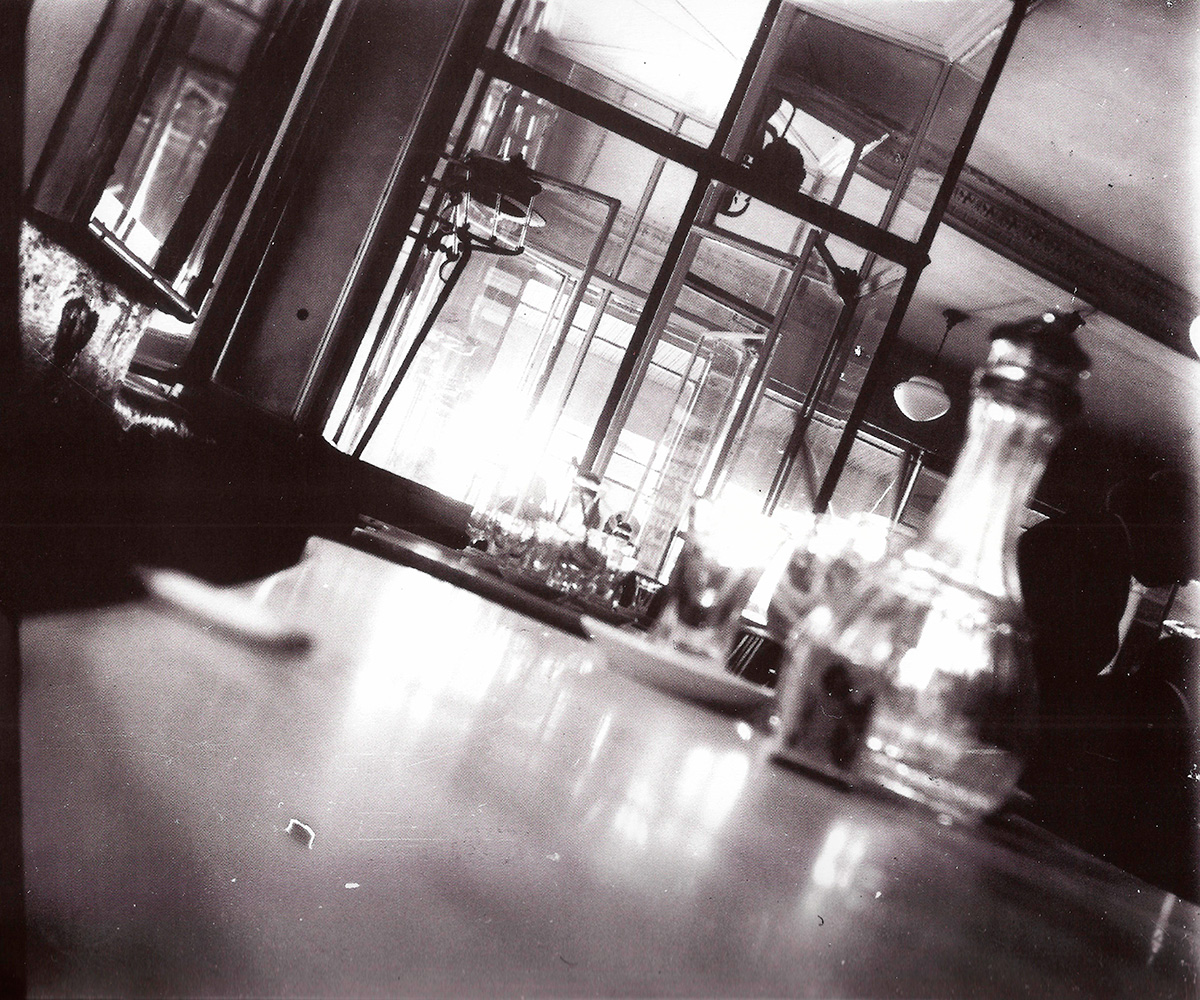
Although the list is long and flexible, the following were part of the gathering, either as regular or casual members: the brothers Federico and Francisco García Lorca, Francisco Soriano Lapresa (who acted as coordinator), Manuel de Falla (musician), Hermenegildo Lanz (designer and teacher), Juan Cristóbal (sculptor), José Mora Guarnido (diplomat), Constantino Ruiz Carnero (editor of El Defensor). Miguel Pizarro, José Navarro (Arabist), Fernando de los Ríos (politician and professor), Juan José Santa Cruz (engineer) and Antonio Gallego Burín (politician). Federico was, in the early years, the only musician in the tertulia, until in 1918 he surprised everyone with his first book, Impressions and Landscapes, the writing of which he kept secret.
The regular rinconcillistas were joined at the meetings by various artists visiting Granada, among them the musicians Arthur Rubinstein and Wanda Landowska and the writers H. G. Wells and Ruyard Kipling. The spirit of the tertulia members gave rise to such important projects as the Flamenco Song Contest of 1922 in the Plaza de los Aljibes, the tributes to Isaac Albéniz in the Alhambra, and the placing of plaques to Gautier, Glinka and Debussy.
There were also imaginary rinconcillistas conceived for the amusement and irony of the tertulia members. One of their happiest finds was the invention of the poet Isidoro Capdepón Fernández, a supposed bard from Granada who, after emigrating to Guatemala, had returned covered in laurels. Capdepón, an apocryphal and collective poet, was a kind of antihero who represented “all the rhetoric in use at the beginning of the century, the cliché and the singsong, the rhetorical flourish, the verses on the fan, the commemorative ode”, according to Mora Guarnido. His model was the nineteenth-century writer Manuel de Góngora.
To give it a semblance of authenticity, they had the complicity of the director of the El Defensor de Granada newspaper, the ‘rinconcillista’ Constantino Ruiz Carnero, who on January 13, 1923, published a poem by Capdepón announcing his return. This was followed by a sarcastic article by José Mora Guarnido that presented him as “one of the few men left to us, a remnant of those representative characters that during the 16th and 17th centuries filled the world”.
Fernández Almagro, in cahoots in Madrid with Antonio and Enrique Díez Canedo, published in Madrid more chronicles about Capdepón, whom they not only proposed to enter the Royal Academy of Language through the very serious magazine España, but also published the chronicle of his reception.
Another of the characters invented by the rinconcillistas, based on the word converge, was the improbable Swedish composer Konverghen, to whom they attributed a copious work that they later made known everywhere. Melchor Fernández Almagro, then an academic of History, had to stifle his laughter when a colleague confided to him; “It seems incredible that only you and I in Spain know of the existence of the great Konverghen… And then those ignoramuses call themselves critics!”.
Among the most surprising ‘rinconcillistas’ were Nakayama Koichi, Nakita, a Japanese student of diplomacy who had chosen Granada as his residence and who presented himself on his business card as a “bullfighter of emotion”, and Ramón Tortajada, husband of the late 19th century dancer Consuelo La Tortajada who had a picturesque house built in the Mariana Pineda Square, almost at the back of the café, with Moorish traces that was destroyed by a fire in the nineteen sixties.
Granada, Granada…
[Granada, Granada…]
¡oh Granada bella!
[Oh beautiful Granada!]
¡Cómo te engalanas, cómo te embelleces
[How you adorn yourself, how you beautify yourself]
Para el que regresa!
[For the one who returns!]
Soy un granadino que en su juventud
[I am a native of Granada who in his youth]
Derrochó su vida y también su hacienda
[Squandered his life and also his wealth]
En amores vanos, amores de un día
[In vain loves, loves of a day]
-además jugando al monte y en juergas-.
[-and also playing “monte” (card game) and in revelry-.]
Los últimos duros jugando una noche
[The last coins playing one night]
Me compré un pasaje y me marché a América.
[I bought a ticket and left for America.]
Me ha sido benévolo el Chaco infinito,
[The infinite Chaco has been kind to me,]
Y la Pampa ardiente me ha sido benévola.
[And the burning Pampa has been kind to me.]
¡Vuelvo rico a comprar una casa
[I return rich to buy a house]
en la calle Navas o de Pavaneras:
[on Navas Street or Pavaneras Street:]
en la calle Navas do vivió mi madre
[on Navas Street where my mother had lived]
o de Pavaneras, donde vivió…ella!
[or Pavaneras, where she had also lived!]
- Federico García Lorca. Modern Anthology. Edition of Miguel García-Posadas. Comares, 1995.
- Francisco García Lorca. Federico and his World. Alianza, 1990.
- Andrés Soria Olmedo. Fable of Sources. Residencia de Estudiantes, 2004.
- José Mora Guarnido. Federico García Lorca and his World. Losada, 1958.
- Lorca´s location
- El Rinconcillo
- current location
- Chikito Restaurant
- ADDRESS
- Plaza del Campillo, 9
- Web
- https://restaurantechikito.com/en/
- Telephone
- 958 223 364
- info@restaurantechikito.com
- DETAILS OF THE VISIT
HOURS
– Thursday to Tuesday, from 12.30 a.m. to 4.30 p.m. and from 8.00 p.m. to 11.30 p.m.
– Wednesday, closed
